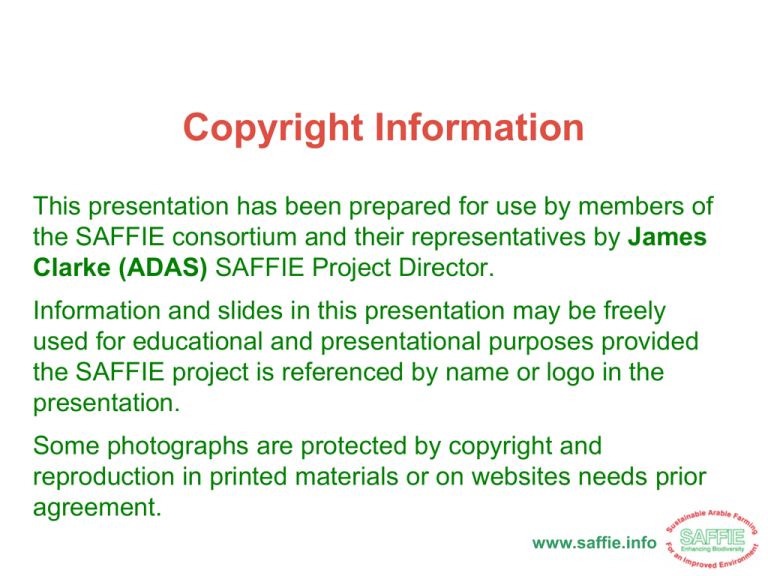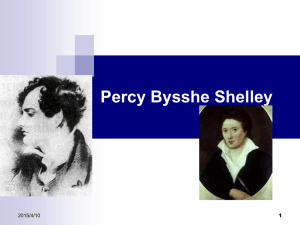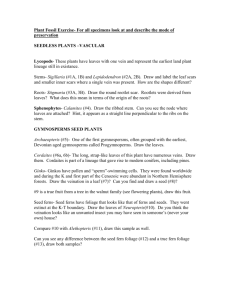2617 Sustainable Arable Farming For an Improved
advertisement

Copyright Information This presentation has been prepared for use by members of the SAFFIE consortium and their representatives by James Clarke (ADAS) SAFFIE Project Director. Information and slides in this presentation may be freely used for educational and presentational purposes provided the SAFFIE project is referenced by name or logo in the presentation. Some photographs are protected by copyright and reproduction in printed materials or on websites needs prior agreement. www.saffie.info Sustainable Arable Sustainable Arable Farming For an Improved Environment - SAFFIE Prepared by James Clarke, ADAS; SAFFIE Project Director & Jeremy Wiltshire, ADAS; Project Co-ordinator www.saffie.info Pressures • Economic - Arable farmers need to optimise inputs and improve efficiency. • Environmental - UK commitment to increase biodiversity, especially farmland bird populations. • Biodiversity Action Plans (BAPs) • Public Service Agreement (PSA) SAFFIE aims to reconcile these pressures by quantifying costs and environmental benefits of new techniques for farmers and policymakers. www.saffie.info Farmland Biodiversity SAFFIE will provide information on: • Birds – indicator species and trends in others • Invertebrates - including food for birds, beneficial species, bees and butterflies • Botanical species - weed species and wild flowers www.saffie.info Specific objectives 1. Manipulate agronomy of wheat to increase biodiversity; 2. Manage margin vegetation to maximise biodiversity; 3. Assess the integrated effects of ‘best’ crop and margin management practices; 4. Conduct a cost:benefit analysis of the best practices; 5. Interact with the farming community to focus the work and promote findings. Five year project: 1 January 2002-31 December 2006 www.saffie.info Skylark Ecology Inhabit open areas – uplands, downland, coasts, farmland Eats seeds, plants & insects Nest on the ground 52% decline in 30 years 3-4 nesting attempts pa Problems for Skylarks Autumn sowing results in loss of stubble for winter feeding. Winter wheat becomes too tall & dense to allow skylarks to re-nest (and feed?). Skylarks re-nesting next to tramlines susceptible to machinery & predators. www.saffie.info Within-crop management Standard v Wide Rows v Skylark Plots Within-field agronomy – crop architecture www.saffie.info More skylark chicks produced per nest in SP treatments 2.5 Mean no. skylark chicks leaving nest per attempt (SE bars) - RSPB 2 1.5 1 0.5 0 pre-June CONV June onwards CONV pre-June SP June onwards SP www.saffie.info Benefits from foraging Later-nesting SP birds still able to feed in the same field in which they nest Skylark foraging - RSPB % foraging in nestfield treatment*date interaction: Wald14.85; df = 2; P< 0.001 100 Early 80 Late 60 40 20 0 Conv SP www.saffie.info Effect of SP on English Skylark populations Data from SAFFIE, Browne et al. 2000 & BBS. . 30,000 Net loss/gain of skylarks pa 25,000 Net loss/gain of birds - 1% pa pop decrease 20,000 = loss of 11500 birds pa 15,000 10,000 5,000 % W. Cereals with SP 0 0 5 10 15 20 25 30 -5,000 -10,000 -15,000 www.saffie.info 35 Summary of outcome from Exp1.1 SP (& WSR) allow longer breeding season More chicks from SP fields SP most consistently beneficial option Indications are that benefits relate to foraging SP cheap & effective solution Skylark Plot option EF8 in ELS (10 points/ha) EL payments more than cover cost of SP Experiment 1.2 Weed management for biodiversity www.saffie.info Weed management for biodiversity • Aim to increase abundance and availability of plant species (esp. those important to invertebrates) in winter wheat • Small scale experiment to control aggressive weeds and leave beneficial plants investigates • Row spacing • Inter-row hoeing • Different herbicide programmes Within-field agronomy – future ICM strategies www.saffie.info Which weeds do we want? Very desirable Desirable Undesirable Annual meadow-grass Common mouse-ear Black-grass Black-bindweed Fumitory Broad-leaved dock Charlock Groundsel Bromes Chickweed Mayweeds Cleavers Fat hen Pansies Couch Polygonums Sowthistles Creeping thistle Wild radish Rye-grasses Crop volunteers Wild-oats www.saffie.info Effects of row spacing + hoeing and selected yield t/ha yield t/ha herbicide programmes on weeds and yields GT&HM 03&04 10 10 9 9 8 8 GT&HM 02&03 4 herbs only 7 6 20 5 7 Undesirable 1 Desirable 2 3 Very desirable 10 15 0 Row spacing (mean of 4 herbicides) Autumn Spring A+S Desirable Very desira 0 Wide + Harrow None 10 5 Wide (Gleadthorpe and High Mowthorpe) over two years. Undesirabl 5 Normal GT&HM 03&04 all spacings Data from two sites 6 20 5 % cover % cover 15 yield t/ha None Autumn Spring A+S Herbicides (mean of 3 spacings) www.saffie.info Results so far • Inter-row hoeing and wide-spaced rows did not improve biodiversity • Herbicides offered more opportunity • Where aggressive weeds were present, it was difficult to preserve desirable species • Spring (only) application of herbicide was best for desirable species • Analysis of results is continuing www.saffie.info Experiment 2 Margin management www.saffie.info Margin management • Seed mixes 1. Grass as in Countryside Stewardship 2. Tussock grass + wildflowers 3. Fine grass + wildflowers • Management treatments 1. Cut 2. Scarify 3. Selective herbicide Margin vegetation www.saffie.info Spring Treatments (March) Sward scarification Cutting Graminicide application www.saffie.info Margin vegetation www.saffie.info Margin vegetation www.saffie.info Sown species Major effect of seed mix; no effect of treatment High Mowthorpe June 2004 Number of species 15 Cut 10 Scar Gram 5 0 CS Tussock Seed Mix Fine www.saffie.info Unsown species No effect of seed mix; big increase from scarification High Mowthorpe June 2004 Cut 10 Number of species Scar Gram 5 0 CS Tussock Seed Mix Fine www.saffie.info Bare ground % No effect of seed mix; big increase from scarification High Mowthorpe June 2004 2 5 .0 % Bare Ground 2 0 .0 Cut 1 5 .0 Scar Graminicide 1 0 .0 5 .0 0 .0 CS Tussock Seed Mix Fine www.saffie.info Vegetation height No effect of seed mix; cutting tallest, except on fine High Mowthorpe June 2004 Vegetation Height (cm) 40.0 35.0 Cut 30.0 Scar 25.0 Graminicide 20.0 15.0 10.0 5.0 0.0 CS Tussock Seed Mix Fine www.saffie.info Ground-beetle species richness More on tussock mix; increases from scarification Species richness 25.0 Cut Scarify 20.0 Graminicide 15.0 10.0 5.0 0.0 CS Tussock Seed Mix Fine www.saffie.info Pollinators – bumblebee abundance Large effect of seed mix; no effects of treatment 140.0 Total no. bumblebees 120.0 100.0 80.0 60.0 Cut Scarification 40.0 Graminicide 20.0 0.0 CS Tussock Fine www.saffie.info Seed-eaters: Count Seed-eating passerines by treatment 18 16 14 12 10 8 6 4 2 0 Cut Scar Gramin May June July Scarification and graminicide - later in the season August Month Insectivores by treatment Insectivores: 12 Count 10 8 Cut 6 Scar 4 Gramin 2 0 May June July Month August Scarification - early to midwww.saffie.info season Scarification may be scary… ...but it’s better for biodiversity www.saffie.info Experiment 3 Integrating crop and margin management www.saffie.info Integrated effects of best crop and margin management Integrating best practice www.saffie.info Experiment 3 – treatments and design • Four treatments: 1. Control = normal for area 2. Best margin and best field centre 3. Best margin management 4. Best field centre practice • 26 sites • Each treatment/plot over 5 ha Integrating best practice www.saffie.info Integrated effects experiment • Integrated effects of Skylark Plots and margin scarification on birds, insects and plants • 26 sites in England & Scotland • Margins & Skylark Plots established • Full monitoring started in April 2004 Integrating best practice www.saffie.info Skylark breeding performance – English SAFFIE sites 2004-05 (95% CI) 4.00 3.75 3.50 3.25 3.00 2.75 2.50 2.25 2.00 1.75 1.50 1.25 1.00 0.75 0.50 0.25 0.00 Total Nests/10ha Brood size post-reduction Chicks/10ha Control Simultaneous nests/10ha Chicks/Nest Best margin and Best margin best field centre Treatment Integrating best practice Best field centre www.saffie.info Do margins enhance predation? Margins facilitate predator movement; acting as corridors Do margins increase abundance of prey & predators? Does skylark nest predation increase with proximity to margin? Skylark: within-crop nest success in relation to distance to treatment edge Best field centre fledged predated 4 3 Best margin Best margin and best field centre 2 1 Control 0 20 40 60 80 100 120 140 160 180 200 220 240 260 280 300 320 340 Dist to edge (m) Integrating best practice www.saffie.info 360 380 Margins and Skylark plots • Benefit of skylark plots alone reconfirmed • Concern that combination of best margins and best field centres reduced benefit to skylarks • Some bird and mammal species may have benefited from margins and combination • Examining possible causes and effects on other species in 2005 • As a precaution advise that skylark plots are located at least 80m from margins Integrating best practice www.saffie.info Costs & benefits www.saffie.info Potential benefit of Skylark Plots For 10ha field Gain from ELS points (20@5 points) £100 Cost of lost production (9.5t/ha@£65/t) £20 Net gain (to cover costs) £80 Worst case management costs <£60 Potential gain >£20 www.saffie.info Potential benefit of Margins (per ha) Cost of lost production (7.6t/ha@£65/t) £494 Saved production costs (inputs, fuel and labour) Net effect on income from margins Annualised cost of establishment and management – no seed Net cost of margins Gain from ELS points (@400 points/ha) Break-even seed cost £389 -£105 £42 £147 £400 £1263 www.saffie.info Margin seed costs (per ha) Countryside Stewardship mix Fine grass and wildflowers Tussock grass and wildflower Optimum seed mix Full seed rate Break-even seed rate £125 +£150/yr £1100 +£32/yr £1300 97% £750 +£102/yr www.saffie.info Costs and benefits • All treatments show potential benefit for: • Profit within ELS • Biodiversity • Benefits will be refined as project concludes to show: • Most relevant options • Suitable seed mixtures www.saffie.info Relevance of SAFFIE Skylark Plots (SP) & margins included in ELS SP cost-effective ELS option SP could help reverse skylark decline Scarification is an exciting and innovative finding with communication challenges Understanding integrated crop/margin treatments is vital Demonstrates role of research in providing future options for arable farming www.saffie.info Acknowledgments Sustainable Arable Project No. LK0926 DEFRA, SEERAD, EN Project No. 2617 Host farms www.saffie.info






